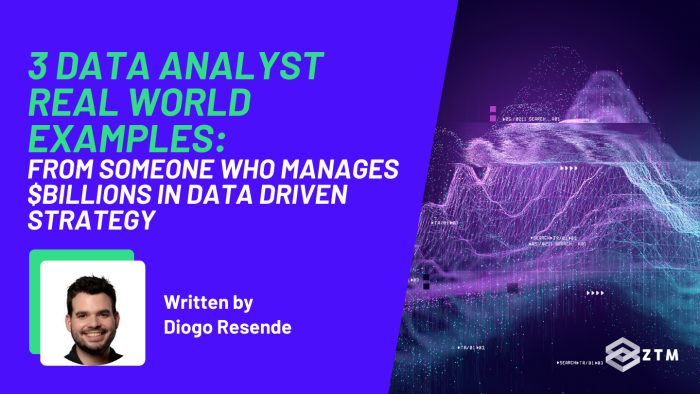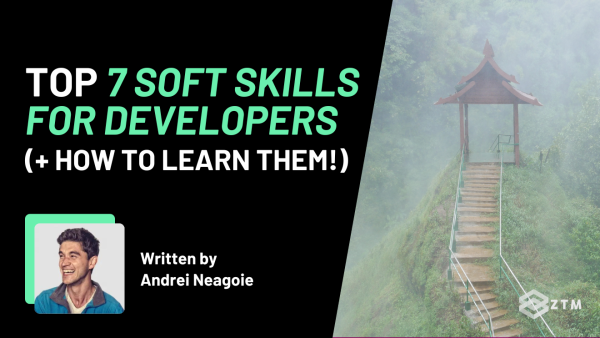It seems simple, but the companies that are best in their field rely heavily on data analysts to help them make data-driven decisions that other companies miss.
In fact, it's usually the reason why they become a market leader and then stay the market leaders while their competitors die off.
Think of businesses like:
- Netflix pivoting from door to door DVD rentals to streaming before the technology really worked
- Disney moving from selling VHS tapes once a year to becoming a studio and buying their competitors
- Uber understanding the best trip distance for maximum efficiency for their drivers
- Starbucks tweaking their pricing, cross sells, locations and floorplans, and more
There’s huge demand in these cutting edge companies for people who can take data, understand what it means and then help make the right choices with it.
It's easier said than done though which is why the salary for a data analyst can be very lucrative, especially for those who learn how to use Data Analysis and Python together.

If you’re thinking about skilling up and becoming a Data Analyst then today’s article will let you take a peek behind the curtain to learn what it’s like to work in this role, from someone who’s in the trenches.
Why listen to me?
My name is Diogo Resende and I’m a Data Scientist & Business Data Analyst based in Berlin, Germany. I'm also an instructor here at Zero To Mastery.

In my day-to-day job, I help to form the strategy and planning of €4 billion in revenue using data-based decision-making.
In this article, I’m going to share 3 data analyst work examples, aka my own war stories from the frontlines of the analytics world.
My goal is to show you exactly what a Business Data Analyst does and how we do it, while also answering some common questions, and including some links to a few free Data Analytics lessons that will explain the tools and concepts in more detail.
I also want to help you see the kind of insights that this kind of analysis can give you, that you might miss if you didn't look at data the way an analyst does.
Sounds good?
Alright, let’s dive in!
Is there a difference between a Business Analyst and a Data Analyst?
Before we get to the examples, let's answer this common question I get.
If we look at if holistically, an analyst is technically a support position but they can have some of the biggest impact on a businesses success.
Their goal is to help provide data-driven decision-making advice for the higher-ups at a company. They look at the numbers, know what they mean, and then gleam insights which they pass on to others.
The thing is, the days when an Analyst only needed to be a spreadsheet ninja are long gone.

In fact, today’s business data analyst role has evolved to require a certain set of skills:
- Robust data analysis
- Knowledge in statistics
- Programming experience, and
- Data Science methodologies
They use things like predictive analytics and causal inference to read that data and make magic happen.
But what’s the difference between a Business Analyst and a Data Analyst? Are they the same thing?
Practically speaking, there’s very little difference other than their additional skill sets or focus.

A simple way of thinking about this is that a Business Analyst needs to be more 'business-driven', whereas a Data Analyst requires a deeper tech stack toolkit.
For example
The traditional Business Analyst needs to be better at soft skills, like stakeholder management, communication, or business insights, while the Data Analyst is more likely to be well versed in SQL and other Business Intelligence tools like Tableau.
But let’s be honest here, jobs and people don’t always fit into neat boxes like those. The reality is much messier and so the truth is that there’s often a lot of overlap between a Business Analyst and a Data Analyst. Therefore the term “Business Data Analyst” is generally used to cover both specialties.
With that out of the way, let’s look at some real-world examples of using and analysing data to get more sales, lower losses and more.
Data Analyst work example #1: The scientific impact of weather on revenue + how we can make this work for us
Erm, what? Why would we care about the weather?
It seems obvious when I point it out, but the weather influences us a great deal. It affects our mood, what we wear, and what we do, but did you know that weather conditions also impact sales?
It’s true. There’s a lot of scientific research about this effect but the problem, of course, is that the weather is an external factor and companies hate external factors because they can’t control them.
Worst of all, without any data analysis, we might just only skim the surface of what we can do when we know this.
For example
A nice sunny day may increase your sales, but what the hell is a company supposed to do with that information? Sure they could try and target warmer areas for physical retail store locations, but the rent is also usually higher there.
But, what else could we do when we understand this impact?
Well let's prove that it actually works first and then we can look at 2 different ways that we could leverage this information.
We can start by drafting up a hypothesis that we can test and apply.
In this example, we hypothesize that a sudden and noticeable temperature change of more than 5 degrees will impact sales.
Put simply, if this turns out to be true and the weather does impact sales, then we can adjust our annual strategy. We could use this knowledge to predict how sales will change based on time of year and store location.
This will help us to attribute and predict a rise or dip in sales before it happens, and then plan around them. We could ensure there is additional inventory at the right stores or hire more staff in advance. There are lots of ways we could use this conclusion.
But of course, we first need to show that the weather would make an impact.
Here’s how you could prove this hypothesis:
First, we need data. We’re investigating both the weather and sales and so the key things we would look at are:
- Daily sales and
- Max temperature for a given location (according to research, the max temperature is the KPI that best reflects weather conditions)
The challenge here is that we cannot control the weather, so we need to fake an experiment to get some data that can help us make a decision. The econometricians call this a quasi-experimental design (fancy, uh?).
So, predicting the weather's impact.
A simple method would be to compare 2 different areas (cities and states) where one is the control group and the other is the treatment group. This is, of course, a simplified explanation of the complex analysis, but for current purposes, this will do!
Imagine we have 2 cities: Berlin and Munich.

If in 1-2 weeks, the temperature is constant in Munich but not in Berlin, you could use this information to then compare the development of sales in both cities.
Assuming there are no other external events such as beer festivals or events local to one city then we can measure the impact of each city's weather on its sales.
For a problem like this we would use a technique from Econometrics called Causal Inference. Specifically, Google Causal Impact, which is a quasi-experimental approach developed by Google, built on a classical Econometrics framework called difference-in-differences.
You wouldn’t think a difference in weather would have much of an impact, but I actually ran these tests for a client and you wouldn’t believe the results.
We found that our hypothesis was true and the weather could not only impact sales, but it could alter them each day by up to 15%.
Not only that, but we also found that there was a seasonality component.
For example
If the temperature increases 5 degrees in March, the impact is 3 times bigger than in July, which makes total sense. During Winter, everyone dreams of Spring and warmer days, but in July, people are more used to the warm weather, so it's less impactful.
Now, you could ask:
“OK, Diogo, great story, very insightful, but what do I do with that information?”
Well, here's a cool thing that we did and it's something you probably wouldn't have thought to do.
Since we knew that a temperature increase in certain months would increase sales by 15%, we used this information to increase our ad spend during those warm spells.
It makes sense right?
We knew that when people wanted to buy more often, we could spend more on ads and be sure that we would see a greater return on investment from each ad dollar. Likewise, if the temp was much lower or it was the peak of summer, we knew we would see less impact and could reduce ad spend (when it would have a lower ROI)!

By getting this data and having the methodology to test and find these insights we went from simply assuming "hotter days means more sales" to knowing:
- On average how much it will affect the sales
- When this lift or drop in sales will likely occur
- That we could take advantage of this by altering the timing of our ad spend based on weather trends - this led to increasing the ROI and efficiency of our ad spend which means more profits!
Pretty cool right?
Data Analyst work example #2: Predicting product returns before they happen, and then reducing them
A lot of business owners operate on their own beliefs and gut feelings and not data.
For example:
Your boss believes that X is the best way to sell a product based on their prior experiences, but is your boss right?
Well, they may be spot on because although it seems like a guess, there is years of experience or data that are driving that gut feeling.
The thing is, what happened in the past is not always a good indicator of what’s happening now and only relying on past information is a recipe for disaster.

There may be small but more recent details that are foreshadowing a bigger change, and so any good Business Data Analyst will look at this belief and ask:
- Did the data support this assumption? Yes or no?
- Does it still support it? I.e is the trend changing?
I can’t share all of the specific details for privacy reasons but I’ve worked on many forecasting projects like this.
This particular example required us to forecast (or predict) the percentage of products purchased that would be returned.

As you can imagine, having a rough idea of how many of your products will be returned and refunded is vital for a business's success. Not only for balancing costs but also for understanding the cause of these refunds and how to improve and reduce them.
But of course it can take a while to put things like this in place.
Now you would think that once you find an issue like this it would be easy and obvious to make a change, but I’ll be honest, even once you find the issue, establishing a new process is never easy.
The implementation from a logistics point of view is normally not an issue - it’s the human element. You see, people dislike change. And so to implement something like this, you really need to work with and for your stakeholders. I.e the people who make the final decisions.
They need to see the value and cost of these issues to get them invested in following through and improving it. The trick is to get them invested early...
Here’s how we did this:
I started by interviewing everyone affected. This meant the end users and customers, but also the domain knowledge experts.

By understanding their needs and concerns it can help to get data points to the holistic causes that are underlying the issue. From these interviews you can then define a plan of how to tackle and solve it using sophisticated tools.
For example
We used Facebook Prophet when working with a client's refund reports.
(Prophet is an open-source forecasting tool using the programming languages R and Python.)
This allowed us to easily implement and scale our forecasting process, while also refining its accuracy.
I can’t give exact details on the campaign due to client confidentiality, but by using Facebook Prophet I managed to decrease the error in their current report from several million dollars in predicted refunds to less than 10!
__Why is this valuable? __
Well the current report was based on past events and gut feelings and not new data which led to a much less accurate forecast.
A less accurate forecast means that they would have had a huge decrease in revenue (we're talking millions of dollars)!
But thanks to these tools we could not only fix this issue and get a more accurate report in advance, but we could also get a far closer approximation of the refund rate today vs the old data.
Better still, because we interviewed key people at each point, the business could use that information to learn different ways to improve and lower their refunds even further.
Great forecasting allows companies to keep a steady hand on the steering wheel, instead of getting surprises!
Side Note
I know that you might be thinking that these results are amazing but here’s a really important piece of advice for budding data analysts:
Always stay in communication and share updates during execution.
Like I mentioned before, managing the human element is a key skill for any Data Analyst. The last thing you want is stakeholders thinking your project is no longer important. You did the hard work to get them on board with this analysis and improvement so make sure you don’t lose them due to a lack of interaction with you!
Stakeholder management is an important part of a Business Data Analyst’s role.
Your stakeholders might be your boss or another team in your company, but try to think of them as your customers. They’re the end-users (aka the people) that will use and act on your analytics, and so their success is your priority.
There are two key aspects to stakeholder management:
- Involving them
- Understanding them and what they want
So let’s break these down.
Involving your stakeholders ensures that they’re aware of what you’re doing and can provide their own feedback. They’re the end-user so their feedback is incredibly important. Working in a company means you’re part of the same community as your stakeholders, and everything is better when you’re pushing in the same direction.
Understanding your stakeholders requires that you collect data to understand what your stakeholders are experiencing, and also what they need.
I.e if they see a dip in sales then you need to be able to find the cause and also understand that they want to fix this. It seems obvious right now but a lot of people don’t communicate this well.
Data Analyst work example #3: Analyzing success and doubling down, even if you didn’t test in advance!
A company I worked with started a new initiative that involved sending a gift to a specific segment of customers just before christmas.

This can be a good idea for businesses to test themselves because free gifts can increase loyalty, lower churn, and boost spending.
However, in this case, the campaign was very rushed and there was no time to run an initial A/B test to find out if the initiative would be worth it or even be profitable when scaled out.
Top tip: Always test first (if possible)!
So without prior A/B test data to work with, a few months passed and a very reasonable question was asked: “Was the initiative worth it? and "Did it work?”
To figure this out we need to look at the data and there's a specific technique we can use given we didn't do the A/B test upfront.
I started looking to answer this question by bringing in three people:
- Someone from the Analytics team, as I knew I wanted my conclusions to be based on what the data said and not on my own beliefs
- Someone from the Operational team that led the project as they knew it best, and
- Someone from the team whose budget paid for it, because they are the key stakeholders
The technique we used to analyze this campaign is called Matching, and it’s one of my favorite techniques.
Matching works by allowing us to kind of simulate how an A/B test might work.
How?
Well, it lets us find among a pool of elements (control group) and which elements or attributes are similar to others in the treatment groups, thus kind of mimicking an A/B test.
In simple terms, it helps us to find people who did X, and then identify characteristics that they have, so that we can then find other people who are just like them.

For example
We ran our campaign through the matching software and looked at everyone in the campaign.
Then we isolated the people who converted and looked at details such as:
- Their buying behavior
- how much they spend
- their age
- gender
- or preferred payment method
Using this, we had a rough profile of the types of people who have performed well so far.
We then used this information to assume that if we targeted other people who also match this criteria, they would also respond the same way. This then allows us to find how many other people fit these criteria and then lets us estimate the impact if we scale out to these other people also.
You might think that you know exactly who your audience is and that you don't need to do this, but you would be surprised.
For example
UK brand Mark's and Spencers found out that almost 50% of their mens underwear is purchased by women!
And so if they only sent their campaigns to men alone, they would miss out on half their sales!
The cool thing is, this isn’t just a theory because we actually used this. We ran matching on the clients campaign and found out that for certain sub-segments of the customers who received the gift, the initiative was a great success because it improved profitability, retention, and revenue from them.
But just as importantly, it also highlighted and matched which people didn't respond well at all so that we could then remove them (and similar people) from future similar campaigns, which is exactly what we did.

Thanks to the data we got from matching, we not only had confidence that this initial campaign worked, but that it could be improved upon.
We then ran the initiative a 2nd time armed with this new information on which customer sub-segments were likely to respond favourably and didn't send to the ones we knew wouldn't respond well.
We increased the budget by five times and as expected, we had an even bigger ROI than the initial successful test run!
We had proof it worked but were able to improve the targeting which lead to not only higher revenue but also at a lower cost than before.
You can imagine how happy the decision makers were when we shared the report with them 😄.
Do you want your own numbers to tell a story or be boring?
So there you have it, 3 ‘in the trenches’ data analyst work examples from my career so far.
As you can see, once you start to understand the context behind the data, it can change how it works for both you and your company.
Suddenly the data is more than just numbers on a screen and can now tell a complex story that the majority of people won’t see and can literally be the difference between thousands or even millions of dollars!
Learning how to analyze data like this will not only help you to understand what your own data means, but you can dramatically change how you act on this information.
- Who would have thought that you should adjust your advertising budget based on temperature changes?
- Or that ladies buy 50% of mens underwear?
- Or that refund rates can fluctuate dramatically from a baseline for a successful product, simply due to a holistic issue? (And can be resolved with research)
If you want to learn more about your own data and how to make it work better for you, then come check out my course on Business Data Analytics here.







